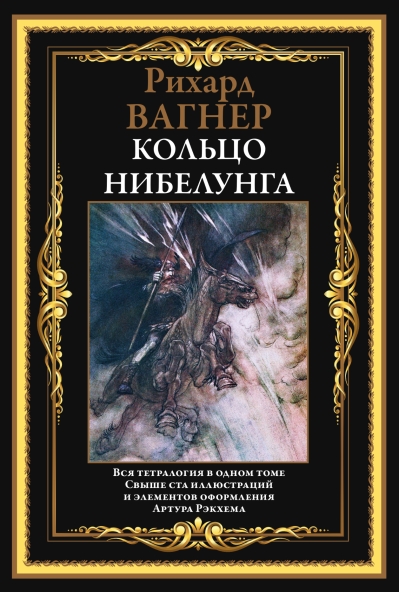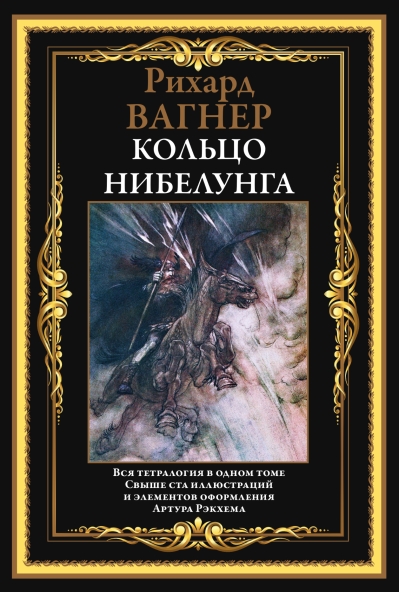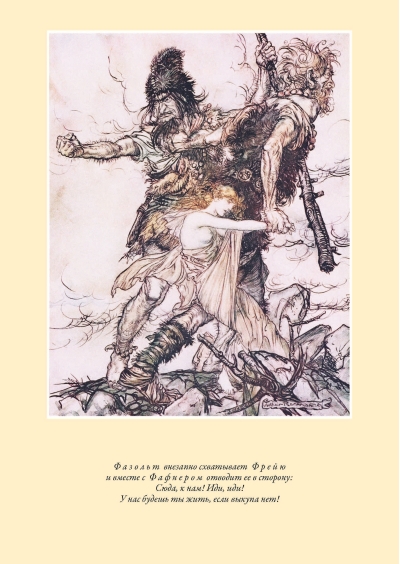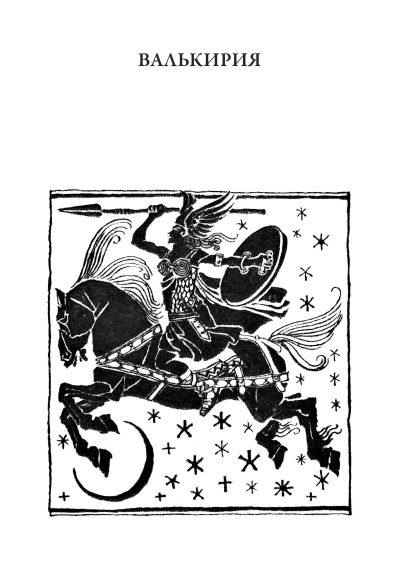The Ring of the Nibelung
29.99 €
In stock
The collection contains texts of four operas by Wilhelm Richard Wagner (1813-1883): "The Gold of the Rhine", "Die Walküre", "Siegfried" and "The Doom of the Gods", which form the cycle "The Ring of the Nibelung". The celebrated composer created these texts himself, drawing on mythology and epic. The translations from the German are by Viktor Kolomiitsov. The edition is preceded by his preface devoted to the peculiarities of translations of Wagner's dramas. The book is decorated with illustrations by the famous British artist Arthur Rackham.
The celebrated 19th-century German composer Wilhelm Richard Wagner considered musical drama to be the highest form of art, in which word and sound are organically combined. He called the classical operas of Rossini and Verdi "candied boredom". Unlike these composers, Wagner himself composed the texts for his musical dramas, which revolutionized opera through the synthesis of poetry, visual, musical and dramatic arts. The most significant work of this kind was his famous tetralogy The Ring of the Nibelung. Wagner began writing the texts for its four epic operas in 1848, studying Germanic mythology, ancient Icelandic sagas, Scandinavian epic and the medieval poem "The Song of the Nibelungs". The tetralogy premiered more than a quarter century later - in 1876 in Bayreuth, Bavaria. All four operas - "The Gold of the Rhine", "The Valkyrie", "Siegfried" and "The Death of the Gods" - were performed one after another from August 13 to 17 on the stage of the opera house built under the direction of the composer himself, the money for which was allocated by Wagner's admirer - Bavarian King Ludwig II. Nowadays this theater still performs operas, including those that made up Wagner's famous tetralogy "The Ring of the Nibelung". You can get acquainted with the texts to them in this book. The edition is decorated with works by the famous artist Arthur Rackham, who is deservedly considered the outstanding master of the Golden Age of British book illustration. Young Rackham began his independent life with a modest position as a clerk. However, the clerical routine did not suit him at all. Arthur began to take drawing lessons and by the early XX century. earned himself a reputation as a recognized master of book illustration. His drawings decorated luxury expensive editions, and the originals are often demonstrated at numerous exhibitions, including the Louvre, and sold at international art auctions. Rackham executed hundreds of drawings for fairy tales by the Brothers Grimm and Charles Perrault, for "Alice's Adventures in Wonderland" by Carroll, "Gulliver's Travels" by Swift, Aesop's fables, "Mother Goose's Tales", works by Dickens, Ibsen and Shakespeare, including the medieval Germanic poem "Song of the Nibelungs". In the BML series, Rackham's illustrations adorned a collection of Irish legends by James Stevens. The last works of the master were made by him in 1939 drawings for the famous fairy tale story of Scottish writer Kenneth Graham "The Wind in the Willows". This book with illustrations by Rackham was published after the artist's death.
The celebrated 19th-century German composer Wilhelm Richard Wagner considered musical drama to be the highest form of art, in which word and sound are organically combined. He called the classical operas of Rossini and Verdi "candied boredom". Unlike these composers, Wagner himself composed the texts for his musical dramas, which revolutionized opera through the synthesis of poetry, visual, musical and dramatic arts. The most significant work of this kind was his famous tetralogy The Ring of the Nibelung. Wagner began writing the texts for its four epic operas in 1848, studying Germanic mythology, ancient Icelandic sagas, Scandinavian epic and the medieval poem "The Song of the Nibelungs". The tetralogy premiered more than a quarter century later - in 1876 in Bayreuth, Bavaria. All four operas - "The Gold of the Rhine", "The Valkyrie", "Siegfried" and "The Death of the Gods" - were performed one after another from August 13 to 17 on the stage of the opera house built under the direction of the composer himself, the money for which was allocated by Wagner's admirer - Bavarian King Ludwig II. Nowadays this theater still performs operas, including those that made up Wagner's famous tetralogy "The Ring of the Nibelung". You can get acquainted with the texts to them in this book. The edition is decorated with works by the famous artist Arthur Rackham, who is deservedly considered the outstanding master of the Golden Age of British book illustration. Young Rackham began his independent life with a modest position as a clerk. However, the clerical routine did not suit him at all. Arthur began to take drawing lessons and by the early XX century. earned himself a reputation as a recognized master of book illustration. His drawings decorated luxury expensive editions, and the originals are often demonstrated at numerous exhibitions, including the Louvre, and sold at international art auctions. Rackham executed hundreds of drawings for fairy tales by the Brothers Grimm and Charles Perrault, for "Alice's Adventures in Wonderland" by Carroll, "Gulliver's Travels" by Swift, Aesop's fables, "Mother Goose's Tales", works by Dickens, Ibsen and Shakespeare, including the medieval Germanic poem "Song of the Nibelungs". In the BML series, Rackham's illustrations adorned a collection of Irish legends by James Stevens. The last works of the master were made by him in 1939 drawings for the famous fairy tale story of Scottish writer Kenneth Graham "The Wind in the Willows". This book with illustrations by Rackham was published after the artist's death.
See also:
- All books by the publisher
- All books by the author
- All books in the series Library of World Literature

















































